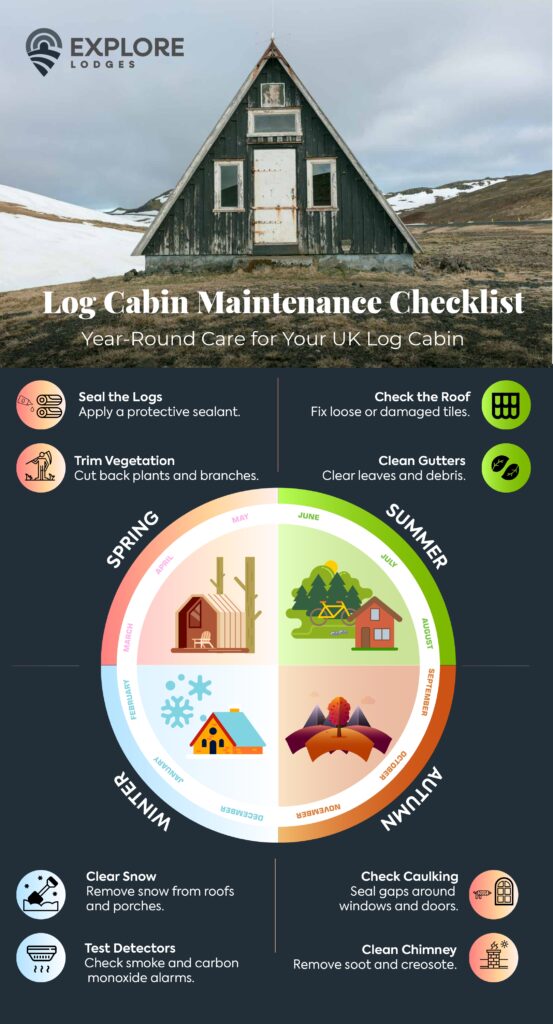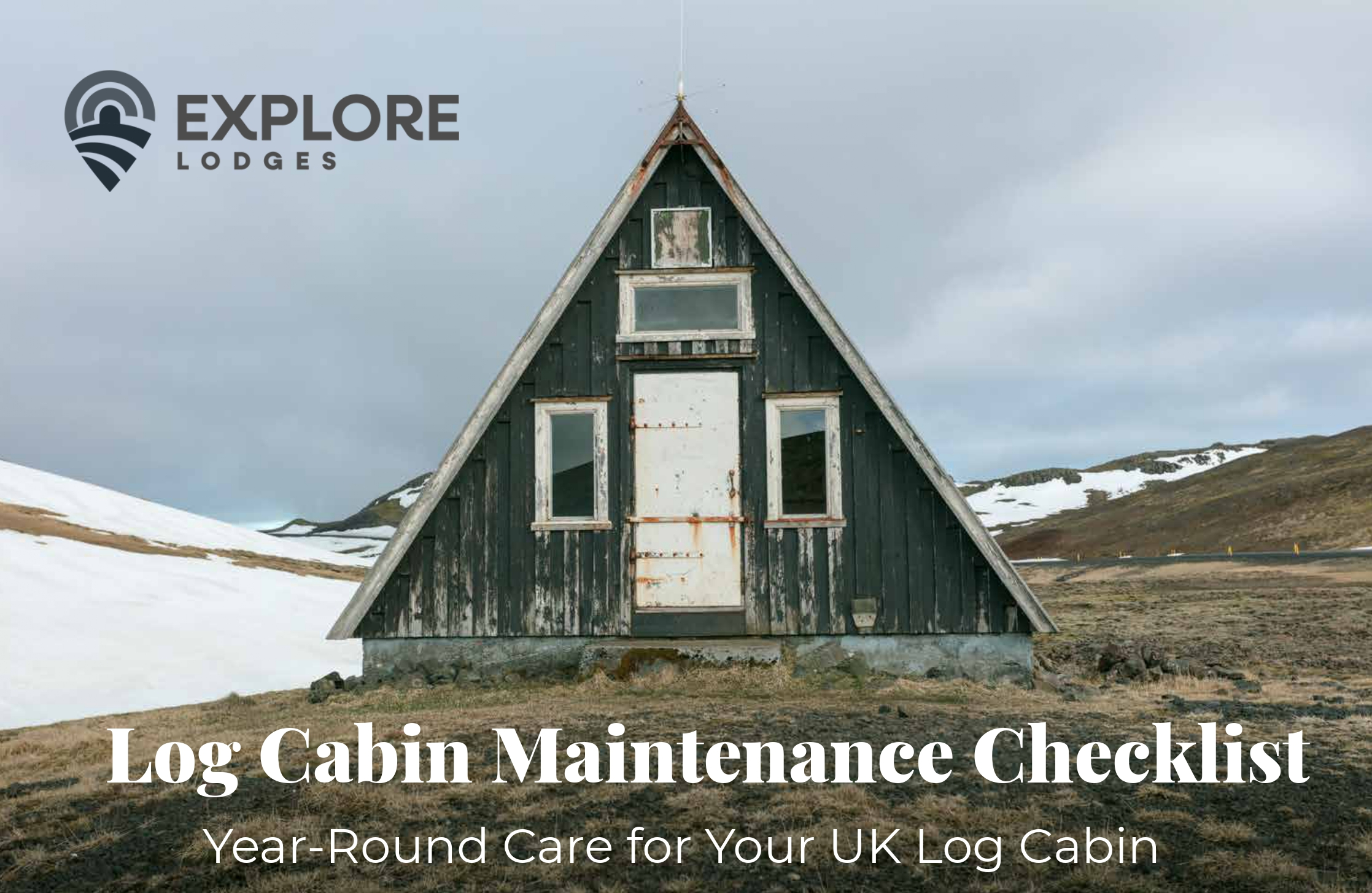Essential Guide to Log Cabin Maintenance
Owning a log cabin is a dream for many log cabin owners, an escape to nature with a charming, rustic home. However, like any property, a log cabin requires regular maintenance to stay in great shape, remain secure, and protect its value over time.
Log cabin maintenance goes beyond aesthetics; it’s crucial for extending the life of your cabin and preventing costly repairs. This guide will walk you through essential tips to keep your log cabin in top condition, focusing on key areas like treatment, inspections, pest control, and moisture prevention.

Download our infographic here.
Understanding Log Cabin Maintenance
Log cabin maintenance is vital for keeping your log home looking great and functioning properly.
Routine maintenance involves regular inspections, cleaning, and treating the wood to safeguard most log cabins against weather, pests, and natural wear and tear.
By prioritising these tasks, you ensure your cabin remains safe, secure, and free from structural issues.
A little attention throughout the year can save you from facing expensive repairs in the future.
Log Cabin Treatment and Protection
One of the most important aspects of log cabin maintenance is treating the wood to ensure the longevity of log homes. Log cabin owners should treat their cabins immediately after construction to prevent wood decay caused by elements like heat, moisture, and air.
Log cabins are particularly vulnerable to moisture, insects and UV damage, all of which can cause the wood to rot or weaken over time. Regular treatment is essential for keeping the wood healthy and protected.
Oil-based stains and oil-based treatments are commonly used for log cabins, as they offer superior protection from moisture and UV rays. However, water-based treatments can also be effective. It’s recommended to apply a fresh coat of correct treatment every 3 to 5 years to ensure your cabin’s wood remains in excellent condition.
Don’t forget to treat exposed areas of the cabin, like the logs and the exterior surfaces, to keep them safe from the elements.
Inspecting and Cleaning Your Log Cabin and the Surrounding Areas
Regular inspections are key to spotting potential issues early, whether that’s looking at the building itself, the doors or the outside areas.
These inspections should cover both the interior and exterior of your cabin. Pay special attention to windows and doors, ensuring they are properly sealed and treated to protect against weather elements.
Look for cracks, gaps, or any other signs of damage that may require attention.
Cleaning Interior and Exterior Areas of Your Log Cabin
Cleaning is also an essential part of cabin care.
Keeping your cabin’s exterior free from dirt, moss, and debris helps prevent buildup that can damage the wood. A soft-bristled brush and a mild detergent are ideal for cleaning the cabin’s surface without harming the logs.
Be sure to clean the interior as well, particularly areas like the windows, walls, and floors, to keep your cabin inviting and in top shape.
Cabin Roof Maintenance
The roof of your log cabin is a critical structural component. Its the surface that protects your home from rain, snow, and ice, and it’s essential to keep it in good condition and maximise its life time.
Regularly inspect the roof for any missing or damaged shingles, leaks, or signs of wear. Repairing or replacing shingles as needed ensures that the roof remains watertight and secure.
Consider applying a roof covering such as felt or shingles to further protect it from the elements.
These coverings can help extend the life of the roof and prevent water damage that could otherwise seep into the structural components.
Preventing Rain Damage and Moisture Issues
Moisture control is crucial for protecting certain areas of your cabin from rain damage and humidity-related issues.
Installing a damp-proof course or a damp-proof membrane can help keep moisture from rising up through the foundation and into the cabin’s structure. Additionally, ensure that your foundation is well-drained to direct water away from the building.
Ground sheets and proper drainage systems – such as gutters and downspouts – will help prevent moisture accumulation that could lead to damage if left untreated.
Controlling Moisture and Humidity
Controlling moisture and humidity is crucial for maintaining a healthy and durable log cabin, and it’s something that you should pay particular attention to.
Excessive moisture can lead to mold, mildew, and rot, while high humidity can cause warping and cracking of the wood. Water soaks through quickly, so a strong water repellent is vital.
Here are some essential tips to help you manage moisture and humidity in your log cabin:
Proper Ventilation
Ensure your log cabin has good ventilation by installing vents or windows that allow for adequate airflow. Proper ventilation helps remove excess moisture from the air, preventing condensation buildup and keeping the cabin dry.
Dehumidifiers
Consider using a dehumidifier, especially in areas with high humidity. Dehumidifiers effectively remove excess moisture from the air, reducing the risk of mould and mildew growth and protecting the wood from damage.
Damp Proof Course
Make sure your log cabin has a damp proof course (DPC) installed. A DPC is a layer of material, such as plastic or metal, placed between the foundation and the wall logs to prevent moisture from rising from the ground into the cabin’s structure.
Regular Inspections
Conduct regular inspections of your log cabin to identify signs of moisture damage, such as warping, cracking, or discoloration. Address any issues promptly to prevent further damage and maintain the cabin’s integrity.
Maintain a Consistent Temperature
Keep a consistent temperature inside your log cabin to prevent moisture accumulation. Avoid sudden temperature changes, as they can cause condensation to form, leading to potential moisture problems.
By following these tips, you can effectively control moisture and humidity in your log cabin, ensuring the wood remains in excellent condition and your cabin stays comfortable and secure.
Log Home Foundations and Drainage
A well-maintained foundation is essential for the stability and longevity of your log cabin. The foundation should be pressure-treated to prevent moisture damage and rot. A good drainage system is also important, as it prevents water from pooling around the foundation, which could weaken it over time.
In addition to installing a DPC or DPM, check the foundation for cracks or signs of settlement. Proper drainage is key to ensuring that rainwater is diverted away from the cabin, keeping the foundation dry and intact.
Pest Control and Security
Log cabins are particularly vulnerable to pest infestations. Certain pests, such as beetles and termites, can damage support beams and other structural components of wooden homes, emphasizing the importance of quick action to prevent weakening of these elements. Inspect your cabin regularly for signs of pests, particularly in areas like the attic and around the foundation.
Sealing cracks and gaps in the cabin’s exterior is the best way to prevent pests from entering. Installing double-glazed windows and securing doors also improves energy efficiency and helps prevent potential break-ins. Regular pest control treatments can further protect your cabin.
Settlement and Shrinkage
Over time, log cabins can experience natural settlement and shrinkage as the wood ages and adjusts to its environment. This can lead to gaps or cracks between the logs, which may allow moisture to enter and cause damage. Addressing these issues promptly is essential for maintaining the cabin’s integrity.
Fill any gaps or cracks with a flexible sealant that matches the colour of the logs. This will help prevent moisture damage and maintain a tight seal against the elements.
Regular inspections will help you spot these issues before they become more serious.
Eco-Friendly Log Cabin Maintenance Options
For those looking to reduce the environmental impact of their log cabin maintenance, there are several eco-friendly options to consider.
Using natural treatments and materials, such as biodegradable sealants and recycled materials, helps minimise waste and supports sustainable practices.
Additionally, installing energy-efficient features, such as solar panels, high-quality insulation, and energy-efficient windows, can reduce the cabin’s carbon footprint and improve its overall energy efficiency.
Planning and Budgeting for Log Home Maintenance
Planning and budgeting for log home maintenance is essential to ensure your cabin remains in good condition and lasts for many years. Here are some practical tips to help you plan and budget for log home maintenance:
Create a Maintenance Schedule
Develop a maintenance schedule that outlines the tasks that need to be performed regularly, such as cleaning, caulking, and staining. A well-organized schedule helps you stay on top of routine log cabin maintenance and prevents small issues from becoming major problems.
Budget for Maintenance
Allocate a portion of your budget each year for maintenance costs, including materials and labor. By setting aside funds specifically for maintenance, you can address issues promptly without financial strain.
Prioritise Tasks
Prioritise maintenance tasks based on their importance and urgency. Address critical issues, such as moisture damage or structural problems, immediately to prevent further deterioration and costly repairs.
Consider Hiring a Professional
If you’re not experienced in log home maintenance, consider hiring a professional to perform essential tasks. Professionals have the expertise and tools needed to ensure your cabin is properly maintained, saving you time and potential headaches.
Keep Records
Maintain detailed records of all maintenance tasks performed, including dates, materials used, and costs. Keeping records helps you track your maintenance history, plan for future tasks, and ensure nothing is overlooked.
By planning and budgeting for log home maintenance, you can ensure your cabin remains in excellent condition, providing a comfortable and secure retreat for years to come.
Common Log Cabin Maintenance Mistakes
While log cabins are low-maintenance, neglecting regular care can lead to expensive repairs.
Common mistakes include using harsh chemicals or abrasive cleaners, failing to inspect the roof and foundation regularly, and not applying treatment to the logs on time.
Avoid these pitfalls by staying proactive about your maintenance tasks.
Log House Maintenance Costs and Considerations
The cost of log cabin maintenance can vary depending on the size of the cabin, its location, and the materials used. However, prioritising maintenance and staying on top of inspections can help reduce long-term costs by preventing major issues. Consider both the cost of materials and the time it takes for proper maintenance when budgeting for these tasks.
Home Maintenance Tips and Best Practices
General Advice for Effective Maintenance
Regular maintenance is the cornerstone of a well-preserved log cabin. Here are some essential tips to keep your log cabin in top shape:
- Create a Routine Maintenance Schedule: Establish a regular maintenance schedule to stay on track and prevent costly repairs. Consistency is key to catching small issues before they become major problems.
- Regular Inspections: Conduct thorough inspections of your log cabin, both inside and out. Look for signs of wear and tear, such as cracks, gaps, or moisture damage. Early detection can save you time and money in the long run.
- Keep Detailed Records: Maintain a log of all maintenance activities, including dates, materials used, and any repairs made. This record will help you track progress and identify recurring issues that may need more attention.
- Prioritize Tasks: Not all maintenance tasks are created equal. Prioritize based on urgency and importance, addressing critical issues like moisture damage or structural problems first.
- Hire Professionals When Needed: If you’re unsure about how to perform a particular task or lack the necessary expertise, don’t hesitate to hire a professional. Their experience can ensure the job is done correctly and safely.
By following these general maintenance tips, you can keep your log cabin in excellent condition and avoid unexpected repairs.
Strategies for Long-Term Care
Ensuring your log cabin remains a cozy and secure retreat for years to come requires a proactive approach. Here are some long-term care strategies to consider:
- Develop a Comprehensive Maintenance Plan: Address all aspects of your log cabin, including the roof, walls, foundation, and hardware. A well-rounded plan ensures no area is overlooked.
- Invest in High-Quality Materials: Use materials and products designed to withstand the elements and last for many years. Quality materials may have a higher upfront cost but will save you money on repairs and replacements in the long run.
- Implement Preventative Maintenance: Regular inspections and maintenance activities can prevent issues before they arise. This proactive approach helps maintain the cabin’s integrity and reduces the risk of costly repairs.
- Ensure Proper Ventilation: Good ventilation is crucial for moisture control. Install vents or windows that allow for adequate airflow, preventing condensation buildup and reducing the risk of mold and mildew.
- Consider Dehumidifiers or Ventilation Systems: In areas with high humidity, dehumidifiers or ventilation systems can help maintain a healthy indoor environment. These devices effectively remove excess moisture from the air, protecting the wood and ensuring a comfortable living space.
By incorporating these long-term care strategies into your routine log cabin maintenance, you can enjoy a safe, comfortable, and beautiful log home for many years to come.
Log Home Maintenance: Ready to Care for Your Log Cabin?
Proper log cabin maintenance is key to ensuring your cabin remains a comfortable, secure, and beautiful retreat for years to come.
By following a regular maintenance schedule, including on windows and doors, and performing essential tasks like reapplying wood treatment, roof inspections, pest control, and moisture management, you’ll be protecting your investment and enjoying your cabin for many seasons.
Whether you’re using eco-friendly treatments or ensuring your foundation is solid, or your focus is on long lasting UV protection and wood preservatives, the time spent on maintenance now will pay off in the long run. That’s why log cabin maintenance is strongly advised, as is paying attention to the manufacturer’s guidelines. You can’t completely remove the risk of log cabin damage, but keeping up top of maintenance makes a big difference.


